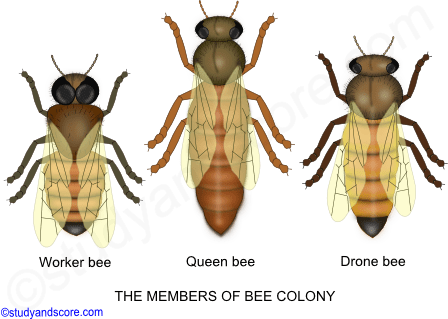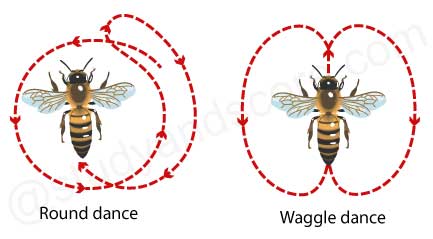Apiculture is the commercial production of Honey. Honey is mentioned in ancient books like Vedas, purana and epics like Mahabharata and Ramayana. It has been an important element in the sweet diet of man. Before knowing the manufacture of sugar, man depended largely on honey as sweetener. Honey is produced by honey bees.
Honey bees have been very closely associated with humans since ancient times and have reached highest degree of domestication. The first evidence of this association between man and bees came to light from the rock paintings made by primitive human. Thousands of years ago, Egyptians were well acquainted with bee keeping before the Christian era.
Apiculture is breeding honey bees for the production of honey and bees wax using modern scientific and commercial methods. The name apiculture is due to the scientific (generic) name of the honeybees which is ‘Apis’. Bee culture or apiculture is practices throughout the world. In India it is practiced in South as well as North India as cottage industry providing employment to lakhs of people. Two institutes namely, Khadi and Village Industries Commission and Indian Council of Agriculture research are making an effort to the raise the industrial status of apiculture in India.
Selection of surrounding flora
The place where the honey bees are kept is called as Apiary. The local surrounding flora is very important for selecting the location of the apiary. It is best practice to choose more nectar-yielding plants like neem, jamun, soapnut etc. in the surroundings. Plants like cherry, sheesham, coconut and guava serve both for nectar and pollen. Best choice of pollen yielding plants is maize, rose and sorghum.
Selection of honey bees
Selection of a good variety of honey bees is an important step before starting apiculture. In general the honey bees for the apiculture must have,
1. High honey yielding capacity
2. Must be able to form the hive anywhere
3. Worker bees must be smart and energetic
4. Must be able to protect themselves from the enemies
5. Must possess colonial habit
The following is the description of are four common species of honey bee found in India. Out of these four Apis indica is best suited for Indian apiculture industry.
Apis dorsata (The rock-bee or Giant honey-bee)
Apis indica (The small Indian bee)
Apis florea (The little bee)
Apis mellifera (The European bee)
Importance of bee keeping
The nest of the honey bee is known as the bee-hive. The population of an average sized colony consists of 30 to 50 thousand individuals. A colony is termed ‘weak’ or ‘strong’ according to the number of worker bees it possesses. There are three types of individuals in a colony, namely the Queen, worker and drone. Due to the existence of several morphological forms, bees are said to be a polymorphic species. The following is the description of each type of member of the bee colony,
The Queen bee
The following are the qualities of the Queen bee

The Worker bee
The following are the qualities of the worker bee
The functions of worker bees are as follows,
Worker bees are again of different types depending on the type of work they do,
Laying worker: These worker bees lay unfertilized eggs in the absence of the queen bee.
Nurse workers: They serve the queen with royal jelly, larvae and drones with honey and beebread.
House workers: They perform house cleaning, comb building, accepting nectar and pollen for foragers and finally guard the hive.
Field workers: They travel to distant places to collect the nectar, pollen grains and resin from the flowers.
The Drone bee
The following are the qualities of the drone bee,
Just like any other animal, bees locate their food through sensory input and an understanding of the features of their environment. They can find their food both by scent and sight. According to Prof. Karl Ernst Von Frisch, an Australian scientist, the foraging bees return to the hive and indicate there inmates about the sources of nectar and pollen by performing certain rhythmic body movements called as the bee dance or bee dance language. This bee dance is readily understood by other bees of the colony.
The life of a solitary bee depends on her ability to find food, gather it and return it to the nest. On the other hand the life of a social bee depends on the same things, along with her ability to tell her hive mates about the location of food. Honeybees communicate and teach each other how to find food, water, resin and new nest sites by dancing. When a honeybee finds food, it uses two known tools to understand the location.
Solar Compass: This tool helps her remember location of the food or hive in relation to the sun The bee's ability to see polarized light lets her determine where the sun is even though when sun is covered by clouds.
Internal Bio-clock: This tool helps her keep track of how far she has flown and how much the sun moved during her journey. In other words, when she returns to the hive, she can tell her sisters exactly where the food is in relation to the current position of the sun. As a bee matures, she also learns about sun's path across the sky during different seasons of the year and at different latitudes if her hive is moved.

The area on which she performs the dance is commonly known as the dance floor, and the worker bees who observe the dance are followers.
Round dance: When the food is nearby, the bee performs a round dance by travelling in circles once to left and once to right.
Waggle dance: When the food is far away in other words more than 100 meters away, the bee performs a waggle dance. The waggle dance involves the shivering of the abdomen in side-side motion. During this dance the bee forms a figure eight.
The strength of the waggle, the number of times it is repeated, the direction of the dance, and the sound of the bee makes communication amazingly accurate. The dancing bees pause between the dances to give taste of the food.
The following are the few indications about the direction of the food,

- Share with your friends! -
Login to post your comment here...
- or with social Account -